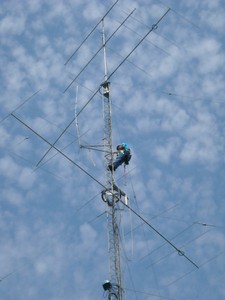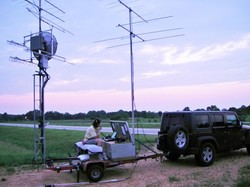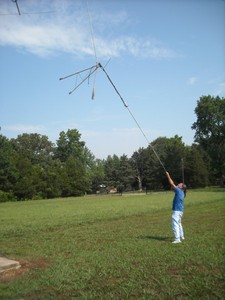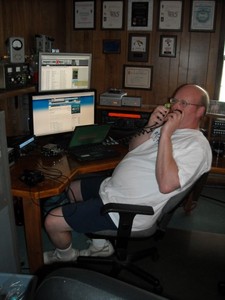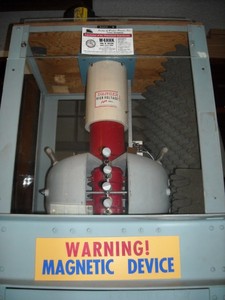 June 22, 2011 Editor: Ward Silver, NØAX | |||||||
IN THIS ISSUE
NEW HF OPERATORS - THINGS TO DO It would be hard to prescribe anything other than a mega-dose of Field Day this weekend - all bands, all modes. Have fun! Regardless of whether that experience wets your whistle or whets your appetite, the annual July 1st Canada Day contest is a great opportunity to point your beams north and join our neighbors in their national day of celebration. BULLETINS There are no bulletins in this issue. BUSTED QSOS Elecraft founder call signs and names were swapped in the story about the new KX-3 last time - for the record, Wayne is N6KR and Eric is WA6HHQ. Also, the call of the Grid Pirates VHF+ team is K8GP, not W8GP - apologies for the busted calls! Log checkers...apply the penalty stick... CONTEST SUMMARY Complete information for all contests follows the Conversation section June 25-26
July 2-3
If you have been on the HF bands lately, you may have noticed that a number of new prefixes are in use by stations in the Russian Federation. Here is a summary of the changes recently adopted by the Russian telecommunication authorities as reported in a recent ARRL Web story containing the numerous details of the new prefix structure. Make sure your logging software's CTY files are up to date before the IARU HF Championship in July! (Thanks, SRR President Roman R5AA, ex-RZ3AA)
More from Dayton - Scott N7SS reports that Icom America was showing off a new mapping feature for VHF+ products. Redhawk is a GPS mike for virtually any radio that features a real GPS display and other features like text messaging. It also allows a user to poll another and get their current location without having to wait or request they transmit. Mapping software will be able to use this data to show live locations on a map - such as for a rover or mobile station. Graphene is not the new fragrance of spreadsheet users, it's a single-atomic-layer allotrope (form) of carbon that makes up graphite. It also has interesting electronic properties that are being put to work in wireless applications, such as a recent frequency mixing ability up to 10 GHz as reported by IBM researchers. Carbon is cheap and ubiquitous so the electronics industry is watching these developments with interest. (Thank, Bob N6TV) The US Representative for serious VHF+ operating-magazine DUBUS, Ed KL7UW, has a new email address that can be used for correspondence with DUBUS or Teckniks, the books of articles from prior issues. Young contest operator Manu LU9ESD has been selected as part of the upcoming 2012 DXpedition to Malpelo Island, HKØNA. Manu's experiences at 6Y1V and PT5T have given him the necessary "chops" to contribute on what will surely be a major operation from a most-needed DXCC entity! Starting with the 2011 edition of the ARRL UHF Contest, the upper power limit for Low Power entries will be 50 watts - an increase from 10 watts. Also note that the power must be measured at the output of the final stage of amplification (see Rule 2). This is a change from the old rules that allowed power measurement at the input to the antenna. Feed line loss is now part of the game. (Thanks, Lloyd N9LB and ARRL Contest Branch Manager, Sean KX9X) Pete N4ZR writes to let us know that, "At Contest University (CTU) in Dayton this year, I gave a "class" on the three most widely used contest logging programs - WriteLog, N1MM Logger, and Win-Test." This was very well received by the CTU attendees! "I have posted PDF versions of the review, as well as my CTU presentation on CW Skimmer and the Reverse Beacon Network." But will they operate EME? China is reported as starting the construction of the world's biggest radio telescope in the remote Guizhou Province of southern China. It will have a diameter of 305 meters and a collecting area of just over 73,000 square meters - the largest aperture ever constructed. This will extend the range of to three times further into space than the famed Arecibo 'scope. Game on!
This may be old news by the time of publication, but in case there are rooms left, the North Coast Contesters (NCC) are pleased to announce that the Crowne Plaza in Dayton, Ohio started taking room reservations for the 2012 Hamvention week on Monday, June 20th under the previously announced agreement for a block rate arranged by the NCC. To make a reservation at the special rate ($135/night) You MUST either call this telephone number to make reservations 937-229- 9852 (special number) or you can make them online. If you call the special number and get the voicemail box - DO NOT leave a message - they cannot call you back. Call back yourself. You must talk to a live operator to make a reservation. A deposit is required at the time of reservation and the hotel cancellation policy applies. (Thanks, Tim K3LR) Web Site of the Week - Although neither of these gentlemen was highly-connected to the radiosport world, both Jim Williams and Bob Pease were intimately involved with the electronic technology that underlies much of what we do, both on and off the air. They were legends in the world of analog electronics design and both died suddenly in the past week. Hams will recognize a kindred soul in this NPR story about Jim's travels through the surplus electronics catacombs of Silicon Valley and his appreciation for technology as shown by this video beginning with him standing in front of his living-room art installation - a recreated Minuteman missile guidance computer. Similarly, the workbench of Bob Pease is legendary for its apparent disorder from which sprouted well-crafted and engineered designs. Both were also legendary for their abilities to write and present with clarity and inspiration - references to Bob's "Pease Porridge" and "What's All This..." columns have made an occasional appearance in this newsletter and both men have authored books considered classics in the field. Personally, both were a huge inspiration to your editor as a writer and author of technical material - having demonstrated how to do it right. To say they will be missed is a gross understatement. (Thanks, Doug K1DG and others for links) WORD TO THE WISE Mentor - this Field Day is an excellent opportunity to mentor new hams, to advise and guide and teach. Take the time to show them what effective operating looks and sounds like - there will be plenty of opportunities to score points and run rate in the weekends ahead of us. Igor, UA9CDC has contributed several videos from the recent Ural Contest Group Championship - the 12th annual competition, held during the first six hours of IARU Region I Field Day. (Part 1, Part 2, Part 3 - the videos were taken and edited by Valery R9DA) Teams are only limited by the 12 meter mast height, Spiderbeam antennas, and 100 watt output power. All the participants are spread out along a North-South line, separated by 200 meters. A video tour of the R9DX contest station is also available.
Brothers Dave N2TEB and Andrew K2FR operated portable from Mount Beacon, NY (FN31al) in the recent ARRL June VHF QSO Party. They managed to work stations out to about 1000 miles before the rain moved in. Enjoy this video of the mountaintop adventure put together by Andrew. Morse Madness strikes when you least expect it, as evidenced by this Bench Press key, a Rocking Chair key, a CW gun (this has potential), a Cheese Slicer key, and even a Rotary dial phone CW key. Listen for OH6DC in the Straight Key Night! (Thanks, Mark K6UFO) If you think contesters are nuts, how about this woodpecker who found a great place to stash acorns? The 2010 ARRL 10 Meter and 2011 January VHF QSO Party results are now online. The ARRL Contest Branch extends its thanks to retiring 10 Meter Contest author Ken WM5R who is a new father and will need to devote more time to his junior operator. ARRL Contest Branch Manager, Sean KX9X notes, "I'm seeing several log submissions for the ARRL June VHF QSO Party that [were submitted in] the Single Operator category, but claim the use of spotting assistance. As a reminder, the use of spotting assistance (packet cluster, DX Summit, Internet chat rooms, etc) places you in a Multioperator category: If you operated on four or fewer bands, you can enter Limited Multioperator; if you operated on five or more bands, you should enter the Multioperator category. If you used spotting assistance during the weekend and submitted as a Single Operator, please resubmit your log in the correct category."
The Seventh District QSO Party (7QP) results have been turned around with the customary blazing speed this group exhibits every year. Click the "2011 Results" tab for the complete story. (Thanks, 7QP Contest Manager, Dick K4XU/N7XU) WRTC2014 Chairman, Doug K1DG notes, "We have been receiving questions about the Team Selection process lately via email at the info@wrtc2014.org address. Please send questions on that subject to selection@wrtc2014.org." In addition, Mark K6UFO sent a pointer to Marek SQ2GXO's WRTC2014 operator comparison website based on claimed results. Marek encourages you to report any bugs or problems. The Claimed Scores for the ARI DX Contest are now published on the Log Received Page - from the ARI home page, click "Log Received". The ARI team wishes to thank Dave, KM3T and kkn.net for support. (Thanks, ARI HF Contest Manager, Bob, I2WIJ) OPERATING TIP Although one's state is not part of most VHF contest exchanges, there are many operators chasing state-level awards such as Worked All States who want to know your state along with the grid. Rather than add state to the exchange, why not add it to your CQ? For example, "CQ contest from W5ZN in EM45, Arkansas." You may pull in a few more callers that way! (Thanks, Bennie K5KV) Trying to keep a straight path when deploying a Beverage antenna in heavy brush or undergrowth (see this blog by N2NL/KH2 for an idea of the problem) is a lot easier with My Tracks, a free Android phone GPS app. (Thanks, José CT1BOH) Recent solar activity predictions have been dismaying to fans of 15 meters and up (while the low-band ops have been secretly cackling with glee). The most recent ARRL Propagation Bulletin ARLP024 contains a host of links about the reports and dissenting opinions. In the meantime, just get on the air and make contacts anyway! Dave N3XUD enthusiastically endorses WinGrid by W4SM as a great grid square tool. The free program calculates grid squares from latitudes and longitudes, the reverse, and calculates distances and headings from two sets of lat/long or grid squares. There are a number of other useful programs there, as well. Knot-knot! Who's there? Alan K2ACK and his collection of Wikipedia links for useful rope tricks; the Figure Eight Loop and the Figure Eight knot, the Double Bowline (that poor rabbit must be going nuts), and the Butterfly.
So you finally bought that neat coax connector crimping tool and die set. But which to use for which connector? Here is a size chart that might be of help in selecting the right crimper die for the right RF connector. There are also standard die sets on the RF Parts and Tessco websites. (Thanks, Bert VE3NR and Les W2LK) Bill N5AB reports success in using an old-fashioned screen door spring at one end of an antenna wire, where the support rope meets the tree, to provide some flex for a wire antenna. He uses a length of rope between the antenna and the metal spring to prevent any undesired coupling between the two. If you are designed an amplifier power supply, you might want to check out the PSU Designer Software from Duncan Amplifiers. This will help insure that you've included all of the important factors that affect supply performance. There are some high voltage supply design examples from G3SEK available, too! Paul NA5N has a lot of excellent parts and building information on his website. When he's not hamming, he works at the National Radio Astronomy Observatory doing some REAL DXing! Roger K8RI is building some adapter plates to mount Yaesu thrust bearings, which are metric, to Rohn 25 accessory shelves, which are not metric. This process is fairly easy to adapt to other similar needs. Technical Web Site of the Week - From time to time someone poses the question as to why coax cables are mostly manufactured in either 75 or 50 ohm characteristic impedances. This article from Microwaves 101 nicely explains why, with both math and graphs. (Thanks, Fred WA7TZY) Caught A Fish! In the recent ARRL June VHF QSO Party, a special event occurred as Mark KMØA completed his Fred Fish Memorial Award (FFMA), working his "last two" grid squares during the contest! This is only the fourth FFMA and quite an achievement! If you've ever been someone's "last state" or "last zone" or "last county", you know it can be almost as much fun on the other end. Here to tell you about it from the rover's perspective are Barry KS7DX and Dennis K7BV and their friend, Ken, who went to great lengths to put CM93 (almost entirely water) on the air - it was quite an adventure! 73, Ward NØAX Firstly I'd like to thank all the folks that sent Dennis and I notes thanking us for doing the trip. It was an adventure to say the least and we were very happy to hand out the grid to so many people who needed it for FFMA. Hearing Mark KMØA calling early Saturday morning, giving him the grid and then hearing him say it was the last one he needed had to be the highlight of the whole trip. When we left on Wednesday he needed two and to find out we gave him the last was just unbelievable! We arrived at Santa Rosa (in California's Channel Islands, grid CM93) on Thursday and proceeded to setup the stations and get the 6M7JHV 7-element Yagi antenna installed. Once it was installed we determined very quickly that it wasn't going to be very good. It was moving around a lot with the rolling of the boat and the constant wind so we took it back down and replaced it with our spare 3-element Yagi. Even that was moving around a lot but with its wider pattern and shorter boom it was easier to move as the boat changed position. And the boat changed position a lot! We'd no sooner get the antenna pointing east and the boat would swing on the anchor and all of a sudden the antenna was pointing west or some other oddball direction! The winds and currents didn't do us any favors. Combine those factors with QSB on the band and you begin to understand why we were loud one minute and gone the next!
Once we had the 3-element up I started to check things out, set levels etc. and in doing so I started calling Jim KS7S on meteor scatter. As soon as the 1st TX sequence ended (using the WSJT software package - Ed.) and I was back in receive I heard Bruce KI7JA calling me! I immediately answered him and the pileup started! There were 3 or 4 stations at a time calling so as fast as I'd work one I had another ready to go. Looking at the log I was averaging 1 station every 5 minutes for the first hour. Not a great run-rate for SSB/CW but not too bad for meteor scatter. I quit shortly after that and Dennis took over mainly on CW for the rest of the evening. Friday morning was again very good for meteor scatter and I added more to the log before Dennis took over on SSB and CW. Friday turned out to be our best day during the whole trip in terms of contacts. The band stayed open until well after midnight with lots of double hop to the east coast. When the band would start to dry up Dennis would switch to beacon mode and eventually someone new would call. What become abundant clear was that the majority of signals we were hearing came from stations with stacked arrays and power. And there we sat with a lowly 3-element waving in the breeze! Saturday morning of course was the red-letter day with Mark KMØA being the first is the log on SSB. The opening was short lived into Missouri but I switched to ISCAT and worked a few in that mode with some SSB and FSK in between. Running WSJT V7 on FSK and V9 on ISCAT meant I could switch between modes quickly and that helped with the short openings. My last digital contact was with Doug VE5UF. After that I went to SSB and got ready to start the contest. Once the contest started it was tough to hold our frequency with so much activity. I had no way of knowing how great the Es openings were except by what I was working and what I heard other stations working. I ended up having to do S&P to be able to work anyone. Being called by some VE3's and some W1 and W2 stations was very cool though. Dennis took over on CW around 0045Z but found the band starting to fade for us. The weather had been deteriorating all day and according to NOAA wasn't going to get any better through the night. With the band conditions not great we decided to take a break and have supper and see how band conditions were later on. We never got the chance! We had no sooner started to eat supper when the weather really turned on us. The anchor was holding but the seas were getting rougher and the winds were increasing badly. In fact the boat was rising and falling so much that the anchor chain would occasionally whip and jump the cogs in the windlass. The latest NOAA weather forecast wasn't encouraging with forecasted winds gusting over 50 mph and seas running 8 to 11 feet. We decided rather quickly to, as the saying goes, get the heck out of Dodge! Getting the anchor up and stowed took more time and effort than any of us thought it would take. After several attempts and a frustrating moment when it jumped its guide and had to be levered back into place it was finally stowed safely and we began heading for cover. By now it was 9:15 PM and too dark to find another anchorage so with the wind pushing us east we decided to head for Oxnard, CA. Finally we got behind the seawall of the Channel Island Harbor and a pilot boat came and directed us into a temporary slip for what was left of the night. It was now 4:30 AM. We over-nighted there Sunday and headed for home Monday morning. After stopping for fuel at Long Beach we finally made it back to Seal Beach around 5 PM. Other than the weather and lack of propagation at times it was good trip and there are 300 or so folks that no longer need CM93. I've posted some pictures of the trip on Picasaweb - clicking a photo will make it bigger. Enjoy! Very 73, Barry KS7DX, Dennis K7BV and Ken 22 June through 5 July An expanded, downloadable version of QST's Contest Corral in PDF format is available. Check the sponsor's Web site for information on operating time restrictions and other instructions. HF CONTESTS ARRL Field Day--Phone,CW,Digital, from Jun 25, 1800Z to Jun 26, 2100Z. Bands (MHz): 1.8-28, 50+. Exchange: Category, ARRL/RAC section or DX. Logs due: Jul 27. Rules QRP ARCI Milliwatt Field Day--Phone,CW,Digital, from Jun 25, 1800Z to Jun 26, 2100Z. Bands (MHz): 1.8-28, 50+. Exchange: Category, ARRL/RAC section or DX. Logs due: Jul 27. Rules NAQCC Milliwatt Sprint--CW, from Jun 22, 0030Z to Jun 22, 0230Z. Bands (MHz): 3.5-14. Frequencies: Monthly on 2nd Tuesday or 3rd Wednesday (alternating). Exchange: RST, S/P/C, and NAQCC mbr nr or power. Logs due: 4 days. Rules SARL Top Band QSO Party--Phone,CW, from Jun 23, 0000Z to Jun 27, 0000Z. Bands (MHz): 1.8. Exchange: RS(T) and province or country. Logs due: 7 days. Rules His Majesty King of Spain--Phone, from Jun 25, 1200Z to Jun 26, 1200Z. Bands (MHz): 1.8-28. Exchange: RS, serial or EA province. Logs due: Jul 15. Rules Marconi Memorial HF Contest--CW, from Jun 25, 1400Z to Jun 26, 1400Z. Bands (MHz): 1.8-28. Exchange: RST and serial number. Logs due: 30 days. Rules Canada Day Contest--Phone,CW, from Jul 1, 0000Z to Jul 1, 2359Z. Bands (MHz): 1.8-28, 50-144. Exchange: RS(T), Province/Territory or serial. Logs due: Jul 31. Rules 070 Club Firecracker PSK31 Sprint--Digital, from Jul 2, 8 PM to Jul 3, 2 AM. Bands (MHz): 7. Exchange: RST and S/P/C. Logs due: Aug 2. Rules Venezuelan Indep Day Contest--Phone,CW, from Jul 2, 0000Z to Jul 3, 2400Z. Bands (MHz): 1.8-28. Exchange: RS(T) and serial. Logs due: Aug 31. Rules DL DX RTTY Contest--Digital, from Jul 2, 1100Z to Jul 3, 1059Z. Bands (MHz): 3.5-28. Exchange: RST and serial. Logs due: Aug 10. Rules DARC 10-Meter Digital Corona--Digital, from Jul 3, 1100Z to Jul 3, 1700Z. Bands (MHz): 28. Exchange: RST, serial. Logs due: 14 days. Rules Ten-Ten Spirit of 76 QSO Party--Phone,CW,Digital, from Jul 4, 0000Z to Jul 10, 2400Z. Bands (MHz): 28. Exchange: Call, name, member number, S/P/C. Logs due: 15 days. Rules MI QRP July 4th Sprint--CW, from Jul 4, 2300Z to Jul 5, 0300Z. Bands (MHz): 1.8-28, 50. Exchange: RST, S/P/C, and QRPMI number or power. Logs due: 30 days. Rules VHF+ CONTESTS ARRL Field Day--Phone,CW,Digital, from Jun 25, 1800Z to Jun 26, 2100Z. Bands (MHz): 1.8-28, 50+. Exchange: Category, ARRL/RAC section or DX. Logs due: Jul 27. Rules QRP ARCI Milliwatt Field Day--Phone,CW,Digital, from Jun 25, 1800Z to Jun 26, 2100Z. Bands (MHz): 1.8-28, 50+. Exchange: Category, ARRL/RAC section or DX. Logs due: Jul 27. Rules Canada Day Contest--Phone,CW, from Jul 1, 0000Z to Jul 1, 2359Z. Bands (MHz): 1.8-28, 50-144. Exchange: RS(T), Province/Territory or serial. Logs due: Jul 31. Rules MI QRP July 4th Sprint--CW, from Jul 4, 2300Z to Jul 5, 0300Z. Bands (MHz): 1.8-28, 50. Exchange: RST, S/P/C, and QRPMI number or power. Logs due: 30 days. Rules LOG DUE DATES 22 June through 5 July June 20 - 10-10 Int. Open Season PSK Contest June 21 - RSGB National Field Day June 22 - UA2 QSO Party June 22 - RSGB 80m Club Championship, CW June 23 - UN DX Contest June 23 - SARL Youth Day Sprint June 26 - Run for the Bacon QRP Contest June 27 - CQ WW WPX Contest, CW June 28 - MI QRP Memorial Day CW Sprint June 30 - EUCW Fraternizing CW QSO Party June 30 - VOLTA WW RTTY Contest July 1 - SBMS 2 GHz and Up WW Club Contest July 1 - Baltic Contest July 1 - Feld Hell Sprint July 1 - UKSMG Summer Contest July 1 - VK Shires Contest July 3 - Alabama QSO Party July 4 - AGCW VHF/UHF Contest July 4 - Maritimes QSO Party ARRL Information Click here to advertise in this newsletter. Your One-Stop Resource for Amateur Radio News and Information ARRL membership includes QST, Amateur Radio's most popular and informative journal, delivered to your mailbox each month. Subscribe to NCJ - the National Contest Journal. Published bimonthly, features articles by top contesters, letters, hints, statistics, scores, NA Sprint and QSO Parties. Subscribe to QEX - A Forum for Communications Experimenters. Published bimonthly, features technical articles, construction projects, columns and other items of interest to radio amateurs and communications professionals. Free of charge to ARRL members: Subscribe to The ARRL Letter (weekly digest of news and information), the ARES E-Letter (monthly public service and emergency communications news), Division and Section news -- and much more! ARRL offers a wide array of products to enhance your enjoyment of Amateur Radio. Visit the site often for new publications, specials and sales. Donate to the fund of your choice -- support programs not funded by member dues! ACKNOWLEDGEMENTS ARRL Contest Update wishes to acknowledge information from WA7BNM's Contest Calendar and SM3CER's Contest Calendar. | |||||||
